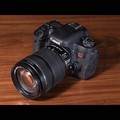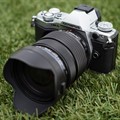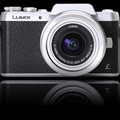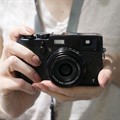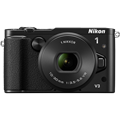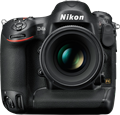Nikon's D7200 has some big shoes to fill. The D7100 was one of our favorite midrange DSLRs of the past few years, and though it's by no means a radical upgrade, the D7200 presents some notable new features. It has a 24.2MP CMOS sensor with no optical low-pass filter, an updated 51-point AF system sensitive to -3EV, a much larger buffer that can take up to 27 Raw images at 6 fps, and Wi-Fi with NFC. Read more
Stories tagged with preview
Canon's two newest professional DSLRs, the 50 megapixel EOS 5DS and 5DS R, share the distinction of offering the highest resolution available in the full-frame class. We've had our hands on the new cameras - take a look at what's new and find out our initial impressions. Read more
Canon has just refreshed the top part of its entry-level Rebel series and it's looking more serious than ever before. The Canon EOS Rebel T6s and its Rebel T6i sibling use the same 24.2MP APS-C sensor and offer a new Hybrid CMOS AF III system with sensor-based phase detection for improved live view focusing. We've spent some time with both models - take a look at a comparison between the models and our impressions on handling them. Read more
At a glance the Olympus OM-D E-M5 II appears relatively unchanged from its predecessor, so you have to look a little closer to see how much work Olympus has put into the new model. The E-M5 II uses a redesigned 16MP Four Thirds sensor and offers a 40MP high-resolution shot mode powered by its 5-axis image stabilization. See its high-resolution mode in action and learn more about the subtle improvements included in the E-M5 II in our First Impressions Review. Read more
The GF7 is the newest member of Panasonic's entry-level line of compact mirrorless cameras, this time with a heavy emphasis on social media. It takes many of its design cues from the Panasonic's stylish GM camera bodies, bringing fresh lines for a look that will appeal to photo purists. How does the new design influence the GF user experience? Read our preview to find out.
The Lumix DMC-GM5 is the newest minuscule ILC from Panasonic. It joins its sibling (the Lumix GM1) by offering nearly all of the same imaging features, including a 16MP Four Thirds sensor, while adding enthusiast-friendly features like an EVF and additional controls. We've been looking at how it handles in the field compared to its predecessor. Take a look at our review-in-progress, complete with studio analysis and shooting experience. Read more
The Nikon D750 is a full-frame DSLR that mates features from the D810 with a 24MP sensor, providing a faster frame-rate than any non-pro full-frame Nikon DSLR since the D700. Its comprehensive still and video photography specifications are aimed directly at enthusiasts and full-frame upgraders. We've made a significant update to our D750 first impressions review including a shooting experience and studio scene analysis. Read more
Canon's successor to the EOS 7D was a long time coming, but the 7D Mark II appears to have all the makings of a DSLR worth the wait. Offering a 20.2MP APS-C CMOS sensor, Dual Pixel AF with 65 phase-detect points and more robust weather-resistance, the 7D II is a formidable follow-up indeed. Our full review is well underway and we've just updated our first impressions with a detailed shooting experience. Read more
We've just added more detail to our Panasonic Lumix DMC-LX100 First Impressions Review including a summary of our shooting experience. Read our updated preview of Panasonic's latest enthusiast compact and find out how it fares in real-world shooting. Read more
From the outside, Canon's PowerShot G7 X enthusiast compact looks like the S-series models that came before it, but inside it's an entirely different story. The G7 X offers a 20MP 1"-type BSI CMOS sensor, a 24-100mm equiv. F1.8-2.8 lens and built-in Wi-Fi with NFC. We've made a substantial update to our First Impressions Review of the G7 X including a writeup of our shooting experience and performance tests. Read more
We've just updated our Fujifilm X100T overview with a detailed analysis of the camera's controls and operation. With access to a beta X100T, we've taken it for a spin and assembled a real-world samples gallery. In the process we've got to know the camera a bit better and have addressed questions about the viewfinder, e-shutter and Auto ISO behavior. Read more
If posts to our news articles and forums are any indication, one of the most exciting announcements from Photokina is the Canon G7 X, a genuinely pocketable camera with a large 1”-type sensor. In this video DPReview’s Richard Butler takes us through a preview of the G7 X and gives us an idea of what to expect from it.
Enthusiast photographers have been waiting in agony for a replacement to the Canon EOS 7D for five years. Their wishes have finally been granted - and in a big way - with the arrival of the EOS 7D Mark II. With a new sensor, improved AF system, faster image processor, and Full HD video, we think that it was worth the wait. For a lot more on the 7D II, read our detailed First Impressions Review.
Panasonic's LX-series of compact cameras have been favorites of both customers and reviewers alike for many years. Photographers who have been waiting for a more enthusiast-slanted LX can finally get out their wallets, because the Lumix DMC-LX100 is here. Find out what we thought about what sounds like the ultimate enthusiast compact camera in our First Impressions Review. Read on.
For the last two years, the only enthusiast compact with a large sensor you could buy says 'Sony' on the front. Finally, at Photokina 2014, we get some competition from Canon. The PowerShot G7 X uses what is likely the same 20MP sensor as the Sony RX100 III but offers a longer lens, flip-up touchscreen LCD, and arguably better controls. For all the details on this exciting new camera, head on over to our First Impressions Review.
Samsung is no stranger to trying something new, and it's really swung for the fences with the NX1 enthusiast mirrorless camera. With a DSLR-style body, a revolutionary sensor, exciting AF system, and more bells and whistles than one could ever need, the NX1 looks like a serious contender. We spent some time with the NX1 and have some first impressions to share. Read'em.
The D750 is Nikon's latest FX format camera, which borrows features from the D810 and marries them with a 24MP sensor, offering a faster frame-rate than any non-professional full-frame Nikon DSLR. Aimed squarely at enthusiasts and full-frame upgraders the D750 boasts a comprehensive video and still photography specification which includes a tilting rear LCD screen and (on paper) an improved version of the 51-point AF system found in the D810. We've been using a pre-production camera for a few days - click through for our first impressions.
If there's one thing you can say about Fujifilm, it's that the company has shown a desire to continuously improve its cameras. In the case of the X100T, Fujifilm has taken the already refined X100S and redesigned the viewfinder, added more exposure controls, and included an electronic shutter. We've spent some time with an early production X100T and have put together an overview that covers the key points. Have a read
As Sony introduces the Alpha a5100 interchangeable lens camera, it officially leaves behind the NEX moniker its mirrorless line originated with. The a5100 picks up where the NEX-5 series leaves off, combining the 24.3 megapixel APS-C CMOS sensor of the a6000 and the more compact footprint of the NEX-5T. The a5100 also inherits many of the a6000's good qualities, including its impressive autofocus system. The a5100 also one-ups its big brother by offering 1080/60p video at 50Mbps. We took a hands-on, preliminary look at the a5100. Read more
Nikon's new D810 consolidates the older D800 and D800E into a single body with no AA filter on its 36MP CMOS sensor. A few days ago we received a final production sample Nikon D810 and we've been shooting with it intensely ever since. As well as putting it through our initial studio testing, we've also taken a quick look at the effectiveness of the new electronic first-curtain shutter and created a gallery of real-world sample images to show what the camera can do. Click through for links.
It's not a surprise that Leica's first autofocus mirrorless system camera is a thing of beauty - nor that it's wildly expensive. The Leica T (Typ 701) uses a 16MP APS-C CMOS sensor, and its operation is almost entirely dependent on a couple of dials and a large touchscreen. It may be beautiful, but a camera can't get by on its looks alone. See how it fared in our field testing. Read more
Panasonic's latest superzoom camera, the Lumix DMC-FZ1000 offers a highly attractive feature set. Based around a 25-400mm equivalent zoom and a large 1"-type CMOS sensor the FZ1000 combines a very useful zoom range with excellent image quality in stills and video mode. We're working our way through a full review right now, and we've just added a shooting experience page to our detailed first-impressions review. Read more
When it was introduced last year, the Sony Cyber-shot DSC-RX10 was peerless. It was the first superzoom to offer a 1"-type sensor, much larger than the 1/2.3"-type chips commonly found in that class. It paired that with an impressive F2.8 constant 24-200mm equivalent zoom. Now the Panasonic Lumix DMC-FZ1000 has joined the RX10 in this newly-minted category, boasting almost certainly the same sensor and a 25-400mm equivalent F2.8-4 lens. They line up nicely for a head-to-head comparison - and that's exactly what we've done. Read more
The Nikon 1 V3 offers an 18.4 megapixel 1"-type CMOS sensor, a significant gain in resolution over its 14.2 megapixel V2 predecessor. It also offers impressive 20 fps burst shooting with continuous AF and a Hybrid AF system using 171 contrast-detect and 105 phase-detect points. The V3 might just be the most promising mirrorless camera Nikon has offered enthusiasts yet, and our full review is well underway. In the meantime, take a look at our first impressions and shooting experience. Read more
The Nikon D810 replaces both the D800 and D800E, and the changes that Nikon has made in the new DSLR are significant. There's no OLPF to get in the way of resolution, and as well as a lower base and higher maximum ISO sensitivity the D810 is 25% faster than its forebears, offers a slightly improved AF system and boasts 1080/60p video with built-in stereo recording. We had a chance to get our hands on a pre-production D810 recently, and we've prepared a detailed look at its key features. Click through to read our First Impressions Review
Kodak is arguably the most famous name of all in photography, but it ultimately failed to manage the transition from film to digital, and ended up exiting the consumer imaging business altogether in 2013. But now JK Imaging, which licenses the Kodak name, has created an interchangeable lens camera. The Pixpro S-1 is an entry-level model that's designed to attract budding photographers who are buying their first system camera. Click through to read our first impressions.
Up until now, the Sony Cyber-shot DSC-RX10 was the only game in town for those seeking a big zoom camera with a larger-than-average sensor. Panasonic has thrown its hat into the ring with the Lumix DMC-FZ1000, which offers a 1"-type, 20.1MP CMOS sensor, plus a longer (but slightly slower) zoom lens. The FZ1000 is also the first compact camera to support 4K video recording. Perhaps the biggest story is the price: $899. We've gotten our mitts on a product model and have some initial thoughts to share. Find out more
Our first impressions review of the Sony Cyber-shot RX100 III just keeps growing. The latest aims to answer one of the most important questions potential owners ask about a camera - 'What's it like to use?' With promising specifications like a 20 megapixel 1"-type sensor, a fast 24-70mm equiv F1.8-2.8 Zeiss-branded lens and a pop-up EVF, the RX100 III looks excellent on paper. Does that hold up in real-world use? Read more
The Sony Cyber-shot RX100 III may have photographers drooling over its fast lens and pop-up electronic viewfinder, but it gains some serious video-related updates too. It now features full sensor readout for higher image quality (as previously seen on the RX10), and also supports the XAVC S codec which allows higher bit-rates. In the latest update to our First Impressions Review, we take a detailed look at its movie mode. Click through to read all about it.
As we've been spending more time with the Sony RX100 III, we've published some of our initial thoughts on the Operation and Controls of this highly intriguing camera and expanded our impressions of the pop-up electronic viewfinder. We also shot a short video showing what's new so you can get a first-hand look at the 20MP compact with 1"-type sensor and faster, wider 24-70mm F1.8-2.8 lens. Learn more and see video
Few compact cameras have garnered as much attention as the Sony Cyber-shot RX100 and RX100 II. Sony had managed to squeeze a much bigger sensor into cameras only a little larger than the Canon S-series enthusiast compacts. The RX100 III continues the tradition by adding a wider, faster 24-70mm F1.8-2.8 lens and a built-in, pop-up EVF. Along with a 20MP 1"-type sensor, does the RX100 III remain the ultimate compact for enthusiasts? Learn more in our First Impressions Review
We've updated our first impressions review of the Nikon D4S with our JPEG Tone Curve and Dynamic Range measurements. Included are real-world examples of Nikon's Active D-Lighting modes, which can significantly help in dealing with scenes containing challenging ranges of (dark to bright) tones. Have a look and, as always, you can compare the D4S to any other camera in our database. Learn more
During pre-launch briefings for the T, Leica was very keen to stress the optical quality of the new lenses. Most interestingly, we were told they relied on optical corrections, rather than software to project the best possible image onto the sensor. So with this in mind, when processing some images from the Leica T, we were surprised by a notification that Adobe Camera Raw gave us. See our results
It may look the same as its predecessor, but the Sony SLT-A77 II's insides are quite a bit different. Featuring a new 24MP CMOS sensor and image processor, along with a dramatically improved AF system, this SLT could be one of the best subject-tracking cameras out there. While we've yet to test its performance, we did spend some brief time with the a77 II and have put together our first impressions.
Leica's new T (Typ 701) is the company's first mirrorless interchangeable lens camera with autofocus. While its 'guts' aren't much different than other cameras in its class, the hand-built body is all Leica. We've been able to spend some quality time with the German manufacturer's latest baby, and have put together our first impressions of it. Find out what we think of it thus far.
The Sony a6000 features a 24MP APS-C sensor that includes phase detection AF points across 92% of the frame and 11 fps continuous shooting with subject-tracking. It's the first E-mount camera of its style not to be branded 'NEX'. As we work toward a full review, read our shooting experience report and check out our real-world samples gallery to find out if the a6000 is more than a refreshed NEX-6 by another name. Learn more and see gallery
Canon's PowerShot G1 X Mark II is an intriguing update. It keeps the 1.5"-type sensor from its predecessor, but adds a faster processor, longer and brighter lens, tilting LCD, dual control rings and has Wi-Fi with NFC. The big change for 2014 is no more optical viewfinder. Our first impressions review covers the usual aspects of the camera (Controls, Body and Design, etc.), but also has our Shooting Experience report where we talk about it handles in the real-world. Learn more
It's hard to resist the opportunity to play with a new medium format DSLR, so we quickly took up Ricoh's offer to try out its 645Z. While it may look intimidating, the 645Z is surprisingly accessible, with an experience that feels strangely familiar to those who have handled Pentax cameras like the K-3. It's also a bargain by medium format standards, and not a huge step up from full-frame. Learn more about the 645Z.
The Samsung NX30's launch got rather drowned-out by the other launches around CES. We've been shooting with it over the past few weeks and have written about our experiences. The NX series boasts a strong range of lenses, one of the more advanced Wi-Fi systems and the innovative i-Function system. What impact do these have on how we used the camera? Learn more
Samsung has announced the NX mini, the world's slimmest interchangeable lens camera. It boasts a 1-inch, 20MP sensor and provides all of the wireless connectivity we've come to expect from Samsung's cameras. We spent a little bit of time with a pre-production unit getting to know it, photographing it, and pondering its existence. Take a look at some hands-on photos and read our first impressions of Samsung's latest (and littlest) connected, mirrorless camera.
The Olympus OM-D E-M10 was announced about a month ago, the third addition to the digital revival of the OM line. It lacks the weather sealing of its siblings but inherits a number of excellent features from the existing OM-D models. Sound enticing? We've gotten familiar with the E-M10 over the past few weeks. The full review is on the way but for now, read our shooter's report, and compare the E-M10 to a growing list of cameras in our new studio test scene.
We first laid our hands on the Fujifilm X-T1 about a month ago when it was announced. Now that we've had some time to shoot with it, we've gathered our thoughts on using Fujifilm's latest X-Series camera. The X-T1 offers much of what the X-E2 does, including a 16 megapixel APS-C sensor with on-chip phase detection, but more than that, it offers an SLR-style sculpted handgrip and weather-resistant sealing. Find out what the X-T1 is like to use in the field.
Nikon's latest flagship body, the D4s, gets an updated 16 megapixel full-frame sensor, Expeed 4-level processing, 1080/60p video recording and can now autofocus at up to 11fps. Beyond that it boasts a laundry list of small (but potentially meaningful) improvements over its predecessor. After spending some brief time with the camera, we've prepared some first impressions of the pro-level body. For a detailed analysis of what's new in Nikon's top-of-the-line, take a look at our first impressions review.
The a6000 sits in the middle of Sony's range of mirrorless cameras, just above the a5000 and aging NEX-7. The feature that makes it stand out from the crowd (and not just among Sony cameras) is its Hybrid AF system, which has phase detect points across 92% of the frame. To learn what that means to photographers, and learn more about the a6000 in general, then have a look at our a6000 First Impressions Review.
As part of our forthcoming review, we've been shooting extensively with the Fujifilm X-E2. Dpreview's Richard Butler used the camera on his recent vacation and has written about his experience living with it during that time. It's a small camera that offers a high level of direct control, but does that make it the perfect traveling companion? Read our Fujifilm X-E2 shooting experience to find out
The Olympus E-M10 wraps much of the E-M5's feature set into a smaller, more compact body. It retains core OM-D features like twin dials, a built-in EVF and a 16 megapixel Four Thirds sensor, but manages to fit them into a body that's more Stylus 1 than ILC. It sits below its E-M5 and E-M1 siblings in terms of both price and specifications, but with features borrowed from two very strong predecessors it's potentially a very impressive camera in its own right. Take a look at our first impressions and sample gallery.
The Fujifilm X-T1 has a lot in common with its X-series siblings - bearing an important distinction: it's weatherproof. It does in fact offer many of the same inner workings as the X-E2, including its 16MP X-Trans CMOS II sensor with on-chip phase detection. On top of that it adds a revamped EVF, an OLED panel boasting a claimed lag time of 0.005 seconds. Consider also that it shoots 8 fps with subject tracking and it all adds up to a very well specified package. Read our first impressions review
The Samsung NX30 puts the NX300's 20 megapixel APS-C sensor and Hybrid AF in a DSLR-like body. It also features a tilting electronic viewfinder and a fully articulated 3-inch AMOLED display, along with Samsung's familiar suite of connectivity features. Built-in Wi-Fi is available, as is NFC to mediate faster connections with compatible smart devices. We spent a little time getting acquainted with a pre-production model, and have put together some quick first impressions.
The widely rumored and much-leaked Nikon Df is here. The Df is a 16MP, full-frame DSLR with the sensor from the flagship D4 and the 39-point AF system from the D610 packaged in a body inspired by film cameras from the 1970s. The Nikon Df can't shoot video, but it will accept 50 year-old non-Ai lenses. A lot of Nikon users have been asking for a 'digital FM2' for years. Is the Df that camera? Click through for our first-impressions.
Up until recently, the only 'real' premium superzoom camera was the Panasonic DMC-FZ200. Two weeks ago Sony made a big splash with their pricey Cyber-shot RX10, which features a 1"-type sensor. The Olympus Stylus 1 slots in nicely somewhere between the two, offering a 1/1.7"-type sensor and constant F2.8, 28-300mm equivalent lens in an OM-D-style body. If that sounds appealing, then follow the link to read our First Impressions Review of the Stylus 1.


